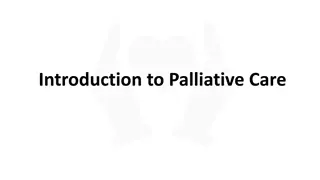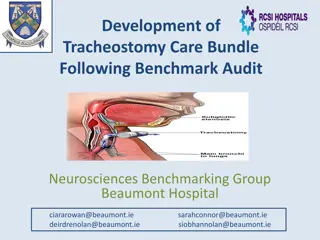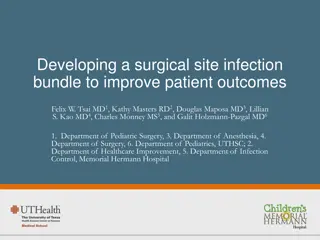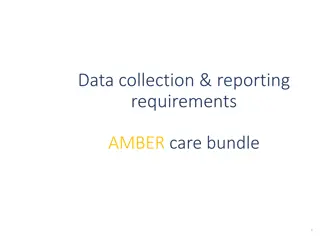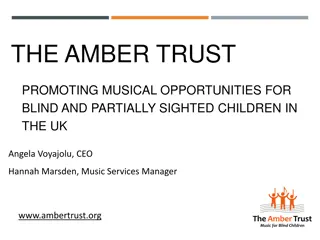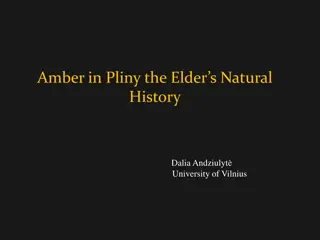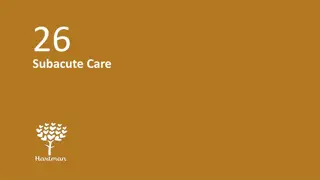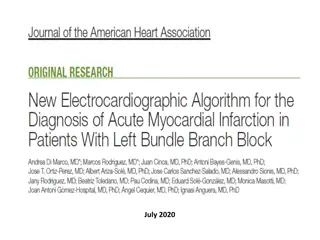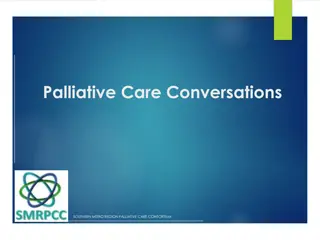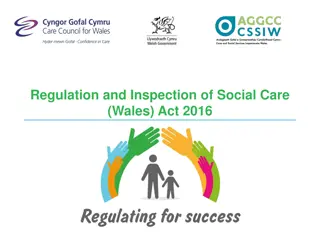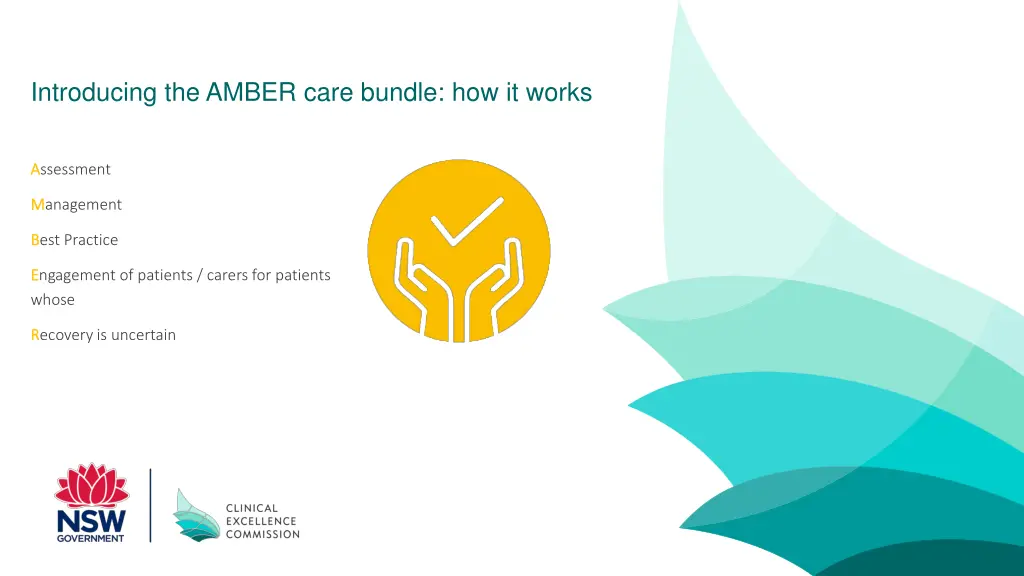
Unveiling the AMBER Care Bundle for Patient Care Excellence
Discover the AMBER Care Bundle designed to enhance patient care through assessment, management, best practices, and engaging patients and carers in uncertain recovery situations. Learn about its implementation steps, impact on clinical units, and the importance of standardized approaches at the end of life.
Download Presentation

Please find below an Image/Link to download the presentation.
The content on the website is provided AS IS for your information and personal use only. It may not be sold, licensed, or shared on other websites without obtaining consent from the author. If you encounter any issues during the download, it is possible that the publisher has removed the file from their server.
You are allowed to download the files provided on this website for personal or commercial use, subject to the condition that they are used lawfully. All files are the property of their respective owners.
The content on the website is provided AS IS for your information and personal use only. It may not be sold, licensed, or shared on other websites without obtaining consent from the author.
E N D
Presentation Transcript
Introducing the AMBER care bundle: how it works A Assessment M Management B Best Practice E Engagement of patients / carers for patients whose R Recoveryis uncertain
Aim of session Provide an overview of the AMBER care bundle Outline the elements of the AMBER care bundle Identify the steps for the LHD/facility/clinical unit inpatient program implementation Clinical Excellence Commission 2
How we die in NSW The case for change Report* examined cost & utilisation of 37,000 people who died in 2011/12 and were hospitalised in their last year of life Average 4 admissions with average LOS of 10 days (average LOS = 4 days) Approx. 984,000 bed days at cost of just over $900 million High proportion of emergency / unplanned admissions **Add local data for this review **Add data from death database around timing of expected deaths resuscitation plan documentation Clinical Excellence Commission 3
The case for change: cont. NSW BTF data shows up to 30% of Rapid Response calls are for patients who are dying as a natural and unpreventable progression of their illness What is the result for your organisation/facility MET data add to presentation Lack of a standardised approach in the last days of life do you have one for organisation/facility? If yes how well is it used? If not how do you know how you manage patients approaching the end of life? Clinical Excellence Commission 4
Patient Story A common concern in IIMS and RCAs is failure of treating teams to identify patients at risk of dying, developing appropriate treatment plans and communicate with patients and carers. Present a case study/complaint here Clinical Excellence Commission 5
What is a Care bundle? Bundle has: - Four to five components - Can be rapidly answered yes/no - Based on good evidence or self evident good practice Can be locally implemented / quality controlled Helps communication and team working Easy to measure Using Care Bundles to Improve Health Care Quality Using Care Bundles to Improve Health Care Quality Resar R et al (2012) (Available on www.IHI.org) BMJ. 2010 Mar 31;340:c1234. doi: 10.1136/bmj.c1234 Clinical Excellence Commission 6
AMBER care bundle Developed at Guy s and St Thomas Trust in the UK Designed to prompt medical teams to have conversations with patients and their carers when recovery uncertain Four components to the approach: 1. Talk to patient and family re concerns about their condition, and discuss preferences and wishes 2. Confirm the current management plan 3. Identify how the patient will be cared for should their condition get worse 4. Agree plan with MDT as well as the patient and family. May still be being actively treated - not waiting until the patient is dying Clinical Excellence Commission 7
Where it fits Clinical Excellence Commission 8
Stage 1 Identifying the patient N.B Any member of the team can identify a patient who is suitable for the AMBER care bundle 1. Is the patient deteriorating, clinically unstable and with limited reversibility? and 2. Is the patient at risk of dying during this episode of care despite treatment? Yes to both AMBER care bundle AMBER care bundle Clinical Excellence Commission 9
Identifying the patient Clinical Assessment - Is the patient s condition serious enough that even with active treatment there is uncertainty that they will recover? Review the patient s admission notes History (co morbidities); recent admissions; physical examination; medications Trigger tools available to give guidance Clinical Excellence Commission 10
Supportive and Palliative Care Indicators Tool Readily identifiable general indicators of deteriorating health commonly present in advanced conditions. Promotes early supportive and palliative care in parallel with optimal management of any underlying conditions as part of routine clinical practice. Evidence-based clinical indicators of all the major advanced, life-limiting conditions and multimorbidity. Contains accessible language and concepts that can be used to initiate discussions with patients and families about goals of care and improve communication between professionals/ teams. Simple, one page format. http://www.spict.org.uk/about/ Clinical Excellence Commission 11
Stage 2 - Day 1 Interventions Within 12 hours of patient identification Within 12 hours of patient identification patient/carer discussion documented in medical record patient's preferred place of care documented medical plan documented in progress notes escalation decision documented for clinical reviews and rapid response team resuscitation plan completed Randomised trials have shown that timely and nuanced discussions around end of life care options can improve quality of life, prolong survival, reduce use of aggressive care and lower healthcare costs. Editorial, Australian Internal Medicine Journal, October 2014 Clinical Excellence Commission 12
Meeting the Patient & Family Meet the patient and family Discuss medical condition and proposed management plan Acknowledge patients uncertain recovery and what will be done by the team and what (if any) time limited trial of therapy will be implemented Identify what the patient / family see as a good outcome Agree on management plan, escalation plan and follow up plan Assess concerns, including potential family interpersonal problems Clinical Excellence Commission 13
Documentation There should be detailed documentation of the conversation with the patient and family/carer around management plan. At a minimum should include: who was present in discussion (both the MDT and family members) what information was given what were patient's concerns/choices did the patient and/or family / carer understand the patient s condition and the goals of care did the patient have a preference for place of death Indicators of symptom/pain control, psychosocial and spiritual support (including family care) were addressed Clinical Excellence Commission 14
Stage 3 - Daily monitor/review ACT A A Is patient still A AMBER? C C Has medical plan C Changed? T T Have you T Talked with the patient and family/carers - Is everything OK? Clinical Excellence Commission 15
Daily monitoring / review using ACT Can be done by either nursing or medical staff or as part to the multidisciplinary round Clarify any concerns with all members of health care team Visit the patient Review treatment plan Discuss patient/family concerns Discuss preferred place of death (if appropriate) Not an add on task done as part of routine daily patient review Document findings, discussions with patient / family and any changes to care plan Clinical Excellence Commission 16
Stage 4 - Cessation Details Reason for AMBER cessation documented AMBER cessation discussed with GP/LMO Document patient wishes/outcomes of discussion on discharge summary Last days of life plan commenced (if applicable) Clinical Excellence Commission 17
Multidisciplinary (MDT) Team & AMBER Medical team Nursing Staff Nursing Staff Can identify patients suitable for AMBER care bundle and discusses with medical staff /MDT Can identify patients suitable for AMBER care bundle and discusses with MDT Educate/support patient and family Initiates and documents patient plan of care Communicate with other members of the health care team Leads and/or participates in daily ACT Manages daily ACT review Participate in multidisciplinary rounds, including those that may be specifically focused on management planning Supports the performance improvement process Allied health staff Allied health staff Can identify patients suitable for AMBER care bundle and discusses with medical staff /MDT Collaborate with care team specific to management needs Assist with patient / family education or questions Clinical Excellence Commission 18
The role of other clinical teams Specialist Palliative Care Teams Specialist Palliative Care Teams may prompt ward based teams to consider if patients are suitable for the AMBER care bundle. SPC teams can support use of the tool eg difficult conversations . Critical Care Outreach / Medical Emergency Teams Critical Care Outreach / Medical Emergency Teams may prompt ward based teams to consider the AMBER care bundle when called out. They may also be involved in developing escalation plans and setting ceilings of treatment with ward based team and in consultation with patient carers. Critical care teams may use the AMBER care bundle when patients are stepped down from critical care to ward based care if the patients recovery is uncertain. Allied Health Professionals Allied Health Professionals may prompt the clinical team to consider the AMBER care bundle and also may support suitable patient s care with the AMBER care bundle. Clinical Excellence Commission 19
AMBER care bundle supports Quality: Quality: enhanced patient and carer experience and satisfaction through early and consistent conversations about care and treatment choices; Productivity: Productivity: helping to avoid hospital readmissions through early recognition of end of life care needs, efficient team working and fewer unwanted tests and treatments; Prevention: Prevention: by cutting out the delay in recognising and responding to end of life care needs. Clinical Excellence Commission 20
Summary This is what we are already/should be doing for our patients and their families i.e. best practice Empowers and promotes confidence in nursing staff and junior doctors to be their patients advocates Means the patient is heard and has control patient is heard and has control Enhances MDT working Enhances the quality of documentation Should give staff no extra work, if anything it should save staff time Clinical Excellence Commission 21
Contact Details Xx Hospital contacts LHD Executive Sponsor Bernadette King Program Lead | Clinical Excellence Commission E Bernadette.king@health.nsw.gov.au CEC-AmberCare@health.nsw.gov.au E Clinical Excellence Commission 22

![Guardians of Collection Enhancing Your Trading Card Experience with the Explorer Sleeve Bundle [4-pack]](/thumb/3698/guardians-of-collection-enhancing-your-trading-card-experience-with-the-explorer-sleeve-bundle-4-pack.jpg)

